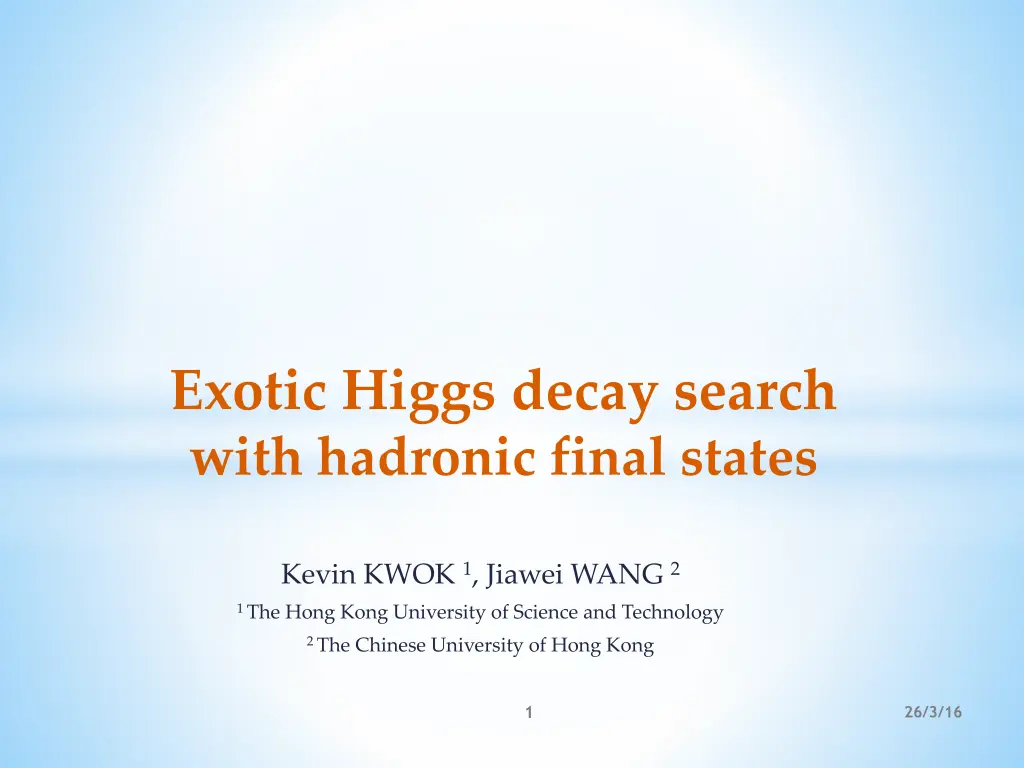
Exotic Higgs Decay Search with Hadronic Final States Study
Explore the search for exotic Higgs decay in hadronic final states at the CEPC collider through detailed analysis and benchmark points scanning, utilizing tools like Madgraph for sample generation and analysis. Backgrounds and results are also discussed.
Download Presentation

Please find below an Image/Link to download the presentation.
The content on the website is provided AS IS for your information and personal use only. It may not be sold, licensed, or shared on other websites without obtaining consent from the author. If you encounter any issues during the download, it is possible that the publisher has removed the file from their server.
You are allowed to download the files provided on this website for personal or commercial use, subject to the condition that they are used lawfully. All files are the property of their respective owners.
The content on the website is provided AS IS for your information and personal use only. It may not be sold, licensed, or shared on other websites without obtaining consent from the author.
E N D
Presentation Transcript
Exotic Higgs decay search with hadronic final states Kevin KWOK 1, Jiawei WANG 2 1 The Hong Kong University of Science and Technology 2 The Chinese University of Hong Kong 1 26/3/16
Motivation ZH is the major production channel in 250 GeV e+e- collider. Using the recoil mass method, the Higgs mass can be precisely measured. Therefore, the exotic Higgs decay search in CEPC is of great interest. The width of 125 GeV SM-like Higgs is very narrow ( 4 MeV) so a small coupling to another light state leads to a sizable exotic decay branching ratio. We study the decay modes which are allowed in NMSSM. 2 26/3/16
Signal Semi-invisible 3 26/3/16
Benchmark Points Scan over the parameter space for sensitivity: 1. Fix GeV and make exclusion contours on the and plane with the range: mh0 mh0 10 GeV < < 60 GeV (15,25,35,45,55 GeV) 10 GeV < < 125 GeV (20,40,60,80,100,120 GeV) Fix GeV and make exclusion contours on the and mh0=30 2. plane, with the range: 0 GeV < < 60 GeV (5,15,25,35,45,55 GeV) 10 GeV < < 125 GeV (20,40,60,80,100,120 GeV) Suggested by prof. Liu 4 26/3/16
Sample Generation and Analysis Tools *Sample generation: Madgraph 5 (version 2.3.2), with parton showers and hadronization. No ISR. 1. Full simulation with Mokka and Arbor. 2. *Information such as invariant mass of di-lepton, recoil mass, b- Fast detector simulation and FastJet (version 2.4) clustering. likeness (full simulation only) and invariant mass of di-jet *Results of simulation from fast detector simulation are used for validation of that from full detector simulation. 5 26/3/16
Backgrounds *Higgs background: ?? ???? /cefs/tmp_storage/yant/gridfs/cepc/user/w/weiyq/e2e2h_ 615 *ZZ background: 1. Leptonic: /cefs/higgs/weiyq/E250.Pzz_l.e0.p0.whizard195_bkg 2. Semi-leptonic: /cefs/higgs/yant/E250.Pzz_sl.e0.p0.whizard195_bkg 6 26/3/16
Backgrounds *Tested ?? hadronic decay: *?? ????: /cefs/higgs/yant/E250.Pzz_h.e0.p0.whizard195_bkg *1135600 events in total *41 events passed FSClasser selection 7 26/3/16
Results I 8 26/3/16
Results I 9 26/3/16
Results I 10 26/3/16
Cut chain *Cut 1: 80 GeV < ?ll < 100 GeV *Cut 2: 120 GeV < ?rec < 150 GeV *Cut 3: two b jets (b likeness > 0.9) *Cut 4: 10 GeV < ?jj < 21 GeV *Further cuts including 1) ???????? and 2) angle ??? of between the 2 jets in the ?? recoil frame 11 26/3/16
Results II No cut Cut 1 mll 10355 Cut 2 mrec 10324 Cut 3 b likeness Cut 4 mjj 6668 Signal 11373 7958 ZH BGs 34093 30732 30030 16026 4 ZZ BGs 538790 281198 30825 4274 20 12 26/3/16
Results II No cut Cut 1 mll 15 Cut 2 mrec 15 Cut 3 b likeness Cut 4 mjj 10 Signal 17 12 ZH BGs 34093 30732 30030 16026 4 ZZ BGs 538790 281198 30825 4274 20 ?+?= 1.71, ? ? ?= 2.04 13 26/3/16
Summary *Statistical sensitivity are expected to be achieved in CEPC. *The results from full detector simulation and fast detector simulation are consistent. (for the mjj, will find the reason why fast simulation is > full simulation) 2 / S B 14 26/3/16
Plan 1. Complete the scanning of benchmark points 2. Include all Standard Model backgrounds 3. Increase the number of events in the samples to obtain a more representative result. 15 26/3/16
Thank you 16 26/3/16






















